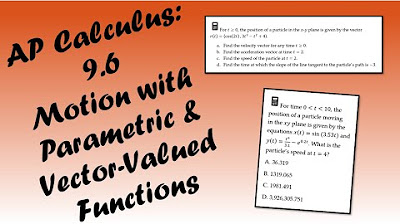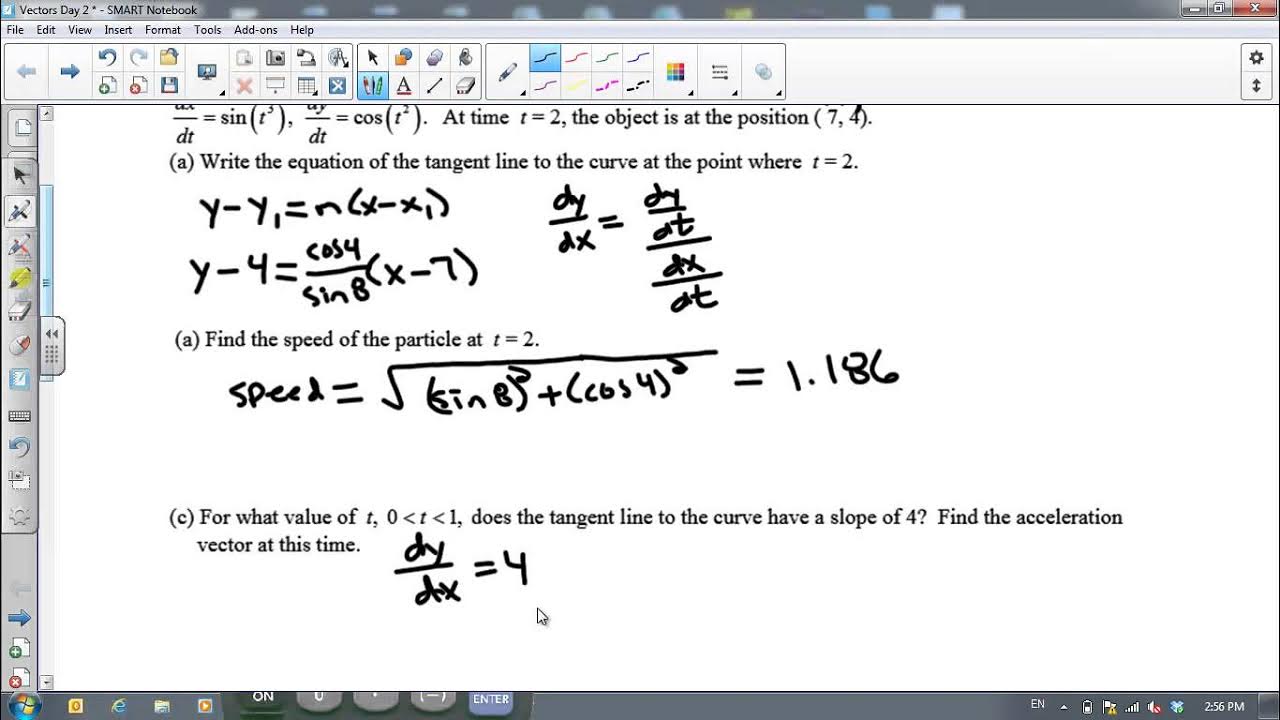2023 AP Calculus BC Free Response Question #2
TLDRThis video discusses a problem from the 2023 AP Calculus BC exam involving parametric equations. It covers finding the acceleration vector of a particle moving along a curve, determining the first instance when the particle's speed reaches 1.5, calculating the slope of the tangent line to the particle's path at a specific time, and computing the total distance traveled by the particle over a given interval. The video emphasizes the importance of using a calculator for accurate calculations and rounding to the third decimal place for final answers.
Takeaways
- 📚 The discussion is based on question number two from the 2023 AP Calculus BC exam, which involves parametric equations.
- 🚀 The particle's position at time \( T \) is given by \( X(T) \) and \( Y(T) \), with \( Y(T) \) being \( 2 \sin(T) \), but \( X(T) \) is not explicitly stated.
- 🔍 The derivative of \( X \) with respect to \( T \) is provided, which is crucial for finding acceleration in part A of the question.
- 📉 The acceleration vector is calculated using the second derivatives of \( X \) and \( Y \) with respect to \( T \), and this is a calculator-based question.
- 📈 Part B asks for the first time when the speed of the particle is 1.5, which involves calculating the magnitude of the velocity vector.
- 🔢 The speed is found using the Pythagorean theorem with the components of the velocity vector, which requires squaring the derivatives and taking the square root.
- 📊 A graph of the speed function is used to find the first time it equals 1.5, which is done using the calculator.
- 📐 Part C requires finding the slope of the tangent line to the path of the particle at time one, which is the ratio of \( \frac{dY}{dT} \) to \( \frac{dX}{dT} \).
- 🧭 The x-coordinate of the particle's position at time one is found by integrating the rate of change of the x-coordinate from time zero to one.
- 🛣️ The total distance traveled by the particle on the interval from 0 to \( \pi \) is calculated by integrating the speed function over this interval, which represents the curve length.
- 📝 Accuracy to the third digit past the decimal is emphasized for the final answers, with rounding or truncation methods being acceptable.
Q & A
What is the initial condition of the particle's position at time t = 0?
-At time t = 0, the particle is at the ordered pair (1, 0).
What is given about the y-component of the particle's position?
-The y-component of the particle's position is given by y(t) = 2sin(t).
What is required to find the acceleration vector of the particle at time t = 1?
-To find the acceleration vector at time t = 1, you need to compute the second derivatives of x and y with respect to t.
How is the speed of the particle at any time t determined for parametric equations?
-The speed is determined by the magnitude of the velocity vector, which is calculated using the Pythagorean theorem: sqrt((dx/dt)^2 + (dy/dt)^2).
How do you find the first time when the speed of the particle is 1.5?
-You set the speed function equal to 1.5, graph the speed function and y = 1.5, and find their intersection point using a calculator.
What is the formula for the slope of the tangent line to the path of the particle in parametric form?
-The slope of the tangent line in parametric form is given by (dy/dt) / (dx/dt).
How do you find the x-coordinate of the particle at time t = 1?
-You integrate the rate of change of the x-coordinate from t = 0 to t = 1 and add this to the initial x-coordinate, which is 1.
What is the process to find the total distance traveled by the particle from t = 0 to t = Pi?
-You integrate the speed function from t = 0 to t = Pi to find the total distance traveled.
How do you ensure the accuracy of your answers in a calculator-based FRQ?
-Ensure the final answer is accurate to the third digit past the decimal, either by rounding or truncating.
What should you do when setting up the integral for the total distance traveled by the particle?
-You should set up the integral of the speed function from the lower to the upper bound of the interval, ensuring correct calculator input.
Outlines
📚 Calculus BC Exam - Parametric Motion Analysis
This paragraph discusses a problem from the 2023 AP Calculus BC exam involving parametric equations for a particle's motion along a curve. The particle's position at time T is given by X(t) and Y(t), with Y(t) explicitly defined as 2 sine of t. The derivative of X with respect to T is provided, but not its value. The task is to find the acceleration vector at time one, which involves calculating the second derivatives of X and Y with respect to T. The solution leverages the calculator's capabilities to find the numerical values for these derivatives. Part B asks for the first time the particle's speed reaches 1.5 within the interval 0 to Pi, which is found by setting up and solving the speed equation using the velocity components. Part C seeks the slope of the tangent line to the particle's path at time one, calculated by the ratio of Y'(T) to X'(T), and evaluated at time one. Additionally, the x-coordinate of the particle's position at time one is determined by integrating the rate of change of the x-coordinate. The final task is to calculate the total distance traveled by the particle on the interval from zero to Pi, which is done by integrating the speed function over this interval. Emphasis is placed on the importance of accurate calculator input and rounding to the third decimal place for the final answer.
🔍 Final Touches on Parametric Problem Calculations
The second paragraph emphasizes the importance of careful calculator input when dealing with parametric problems like the one discussed. It advises to round the final answer to the third digit past the decimal for accuracy. The paragraph serves as a reminder to ensure precision in calculations, especially when using a calculator, and to maintain consistency in the presentation of results.
Mindmap
Keywords
💡Parametric Equations
💡Acceleration Vector
💡Derivative
💡Velocity Vector
💡Speed
💡Tangent Line
💡Integral
💡Curve Length
💡Calculator
💡Rounding
Highlights
Discussion of question number two from the 2023 AP Calc BC exam.
Involves parametric equations with a particle moving along a curve.
Time interval specified as 0 to Pi.
Position of particle at time T given by X(t) and Y(t).
Y(t) is given as 2 sine of t.
Expression for derivative of X with respect to T is provided.
Part A requires finding the acceleration vector of the particle at time one.
Acceleration vector includes second derivatives of X and Y with respect to T.
Calculator can be used to produce numerical values for derivatives.
Part B asks for the first time when the speed of the particle is 1.5.
Speed is the magnitude of the velocity vector.
Velocity vector components are given by derivatives of X and Y with respect to T.
Speed function is graphed to find when it equals 1.5.
Part C seeks the slope of the tangent line to the path at time one.
Tangent line slope is determined by Y'(t)/X'(t).
X coordinate of the particle at time one is calculated by integrating the rate of change of the x coordinate.
Total distance traveled by the particle on the interval from zero to Pi is calculated.
Integral of the absolute value of velocity (speed) is used to find total distance traveled.
Calculations are done on a calculator with careful attention to accuracy.
Final answers should be rounded to the third digit past the decimal.
Transcripts
5.0 / 5 (0 votes)
Thanks for rating:





